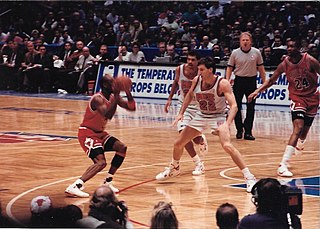
Basketball is a team sport in which two teams, most commonly of five players each, opposing one another on a rectangular court, compete with the primary objective of shooting a basketball through the defender's hoop, while preventing the opposing team from shooting through their own hoop. A field goal is worth two points, unless made from behind the three-point line, when it is worth three. After a foul, timed play stops and the player fouled or designated to shoot a technical foul is given one, two or three one-point free throws. The team with the most points at the end of the game wins, but if regulation play expires with the score tied, an additional period of play (overtime) is mandated.
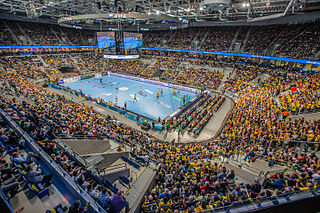
Handball is a team sport in which two teams of seven players each pass a ball using their hands with the aim of throwing it into the goal of the opposing team. A standard match consists of two periods of 30 minutes, and the team that scores more goals wins.

Netball is a ball sport played on a rectangular court by two teams of seven players. The primary objective is to shoot a ball through the defender's goal ring while preventing the opposing team from shooting through their own goal ring. It is one of a few sports created exclusively for women and girls and remains primarily played by them, on indoor and outdoor courts, especially in schools and most popularly in the Commonwealth of Nations.

Volleyball is a team sport in which two teams of six players are separated by a net. Each team tries to score points by grounding a ball on the other team's court under organized rules. It has been a part of the official program of the Summer Olympic Games since Tokyo 1964. Beach volleyball was introduced to the programme at the Atlanta 1996 Summer Olympics. The adapted version of volleyball at the Summer Paralympic Games is sitting volleyball.

Futsal is a football-based game played on a hardcourt like a basketball court, smaller than a football pitch, and mainly indoors. It has similarities to five-a-side football and indoor football.

Dodgeball is a team sport in which players on two opposing teams try to throw balls and hit opponents while avoiding being hit themselves. The objective of each team is to eliminate all members of the opposing team by hitting them with thrown balls, catching a ball thrown by an opponent, or inducing an opponent to commit a violation, such as stepping outside the court.
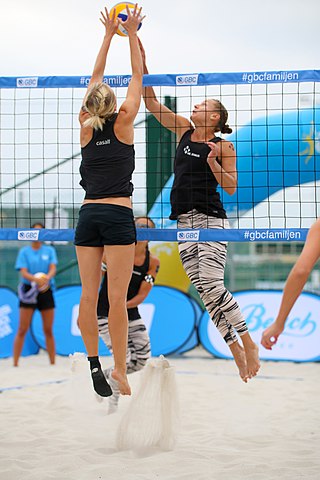
Beach volleyball is a team sport played by two teams of two or more players on a sand court divided by a net. Similar to indoor volleyball, the objective of the game is to send the ball over the net and to ground it on the opponent's side of the court. Each team also works in unison to prevent the opposing team from grounding the ball on their side of the court.

Sepak takraw, or Sepaktakraw, also called buka ball, kick volleyball or foot volleyball, is a team sport played with a ball made of rattan or synthetic plastic between two teams of two to four players on a court resembling a badminton court. It is similar to volleyball and footvolley in its use of a rattan ball and players using only their feet, knees, shoulders, chest and head to touch the ball. Sepak Takraw is often referred to as a mixture of volleyball, due to its use of a net, and association football, as players use their feet.

In sport, a goal may refer to either an instance of scoring, or to the physical structure or area where an attacking team must send the ball or puck in order to score points. The structure of a goal varies from sport to sport, and one is placed at or near each end of the playing field for each team to defend. For many sports, each goal structure usually consists of two vertical posts, called goal posts, supporting a horizontal crossbar. A goal line marked on the playing surface between the goal posts demarcates the goal area. Thus, the objective is to send the ball or puck between the goal posts, under or over the crossbar, and across the goal line. Other sports may have other types of structures or areas where the ball or puck must pass through, such as the basketball hoop. Sports which feature goal scoring are also commonly known as invasion games.
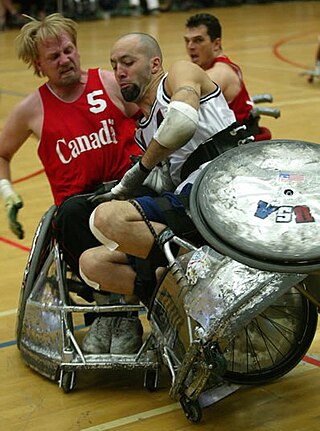
Wheelchair rugby is a team sport for athletes with a disability. It is practiced in over twenty-five countries around the world and is a summer Paralympic sport.
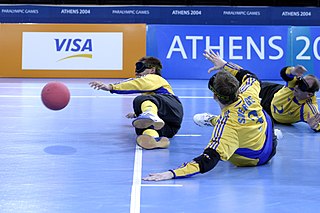
Goalball is a team sport designed specifically for athletes with a vision impairment. Participants compete in teams of three, and try to throw a ball that has bells embedded inside of it into the opponents' goal. The ball is thrown by hand and never kicked. Using ear-hand coordination, originating as a rehabilitation exercise, the sport has no able-bodied equivalent. Able-bodied athletes are also blindfolded when playing this sport.

Cycle polo, bicycle polo, or bike polo is a team sport, similar to traditional polo, except that bicycles are used instead of horses. There are two versions of the sport: Hardcourt Bike Polo and grass court bike polo. The hardcourt game saw a sharp spike in interest in the first decade of the 21st century and new teams are sprouting up across the world in China, Canada, Ireland, Switzerland, France, India, Germany, Pakistan, Ukraine, Russia, Malaysia, Sri Lanka, Indonesia, Hungary, Australia, New Zealand, Sweden, England, Scotland, Argentina, Italy, Spain, United States, Poland, Croatia, Slovenia, Lithuania, Nepal, Brazil and Cuba.

Ball badminton is a sport native to India. It is a racket sport game, played with a yellow ball made of wool, on a court of fixed dimensions divided by a net. The game was played as early as 1856 by the royal family in Tanjore, the capital of Thanjavur district in Tamil Nadu, India. It enjoys the greatest popularity in India. Ball badminton is a fast-paced game; it demands skill, quick reflexes, good judgment, agility, and the ability to control the ball with one's wrist.
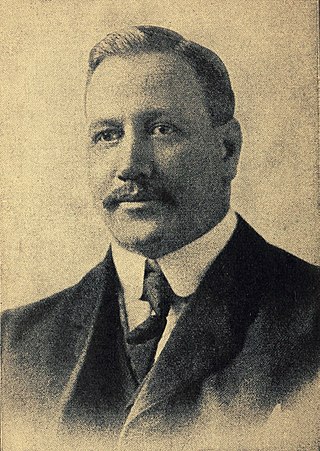
William George Morgan was the inventor of volleyball, originally called "Mintonette", a name derived from the game of badminton which he later agreed to change to better reflect the nature of the sport. He was born in Lockport, New York, U.S.
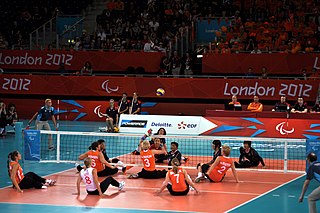
Sitting volleyball is a form of volleyball for athletes with a disability. As opposed to standing volleyball, sitting volleyball players must sit on the floor to play.
Several sports related to volleyball have become popular. Indoor volleyball and beach volleyball are both events at the Olympics, and sitting volleyball is an event at the Paralympics. Other varieties are localized, or are played at an amateur or informal level.

Newcomb ball (also known simply as Newcomb, and sometimes spelled Newcombe (ball)) is a ball game played in a gymnasium or court using two opposing teams and a net. Newcomb ball and the sport of volleyball were both created in 1895 and are similar in their design. The sport rivaled volleyball in popularity and participation by the 1920s. The sport of throwball may be a possible relative.

Torball is a team sport for the blind and vision-impaired. With some similar structures in the rules in the 1980s, it is different to the Paralympic Games team sport of goalball.
Netball is a ball sport for two teams of seven players; its rules are published in print and online by the International Netball Federation. Games are played on a rectangular court divided into thirds, with a raised goal at each short end. The objective of the game is for teams to score goals, by passing a ball and shooting it into the opposite team's goal ring. Players are assigned "positions" that define their role within the team and restrict their movement on court.
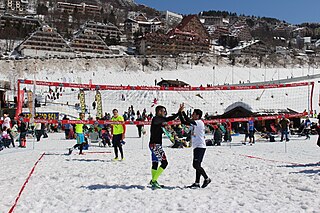
Snow volleyball is a winter team sport played by two teams of three players on a snow court divided by a net. The objective of each team is to score points by sending a ball over the net so as to ground it on the opponent's court, and to prevent the same effort by the opponent. A team is allowed up to three touches to return the ball across the net, and individual players may not touch the ball twice consecutively.



















